How to Calculate Container Volume Using a Container Volume Calculator
A container, at first glance, is just an ordinary cargo space. However, it has brought about a true revolution in goods transportation. The use of containers has sped up the loading and unloading process, reduced the risk of damage and theft, and lowered transport costs. Instead of handling individual items piece by piece, entire containers can now easily be transferred from ships to trains or trucks. As a result, logistics has become faster, safer, and better equipped to handle global shipping volumes. Find out how to easily calculate container volume and make your logistics as efficient as possible.

The Quickest Way to Calculate Container Volume
Are you looking for a quick answer and an even quicker solution? If so, we’ve got four words for you: EasyCargo container volume calculator. Seriously — the app includes 45 predefined cargo spaces, including all standardized container sizes. Therefore, you can easily select the one that fits your needs.
This table includes all container sizes commonly used in transportation.
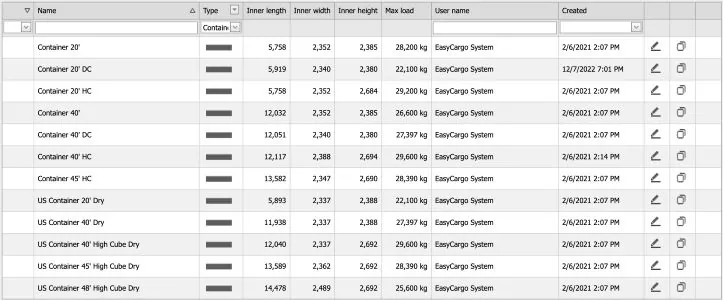
Furthermore, all you need to do is select the container you need, and the app will take care of the rest.
Tip: Check out our article to read about the different types of cargo spaces available and find out which ones are best suited for specific types of goods.
Once you return to the main interface of the app, displayed in the cargo space info panel in the top right corner, you’ll see all of the essential information (weight, volume, free meters) you need to create your load plan.
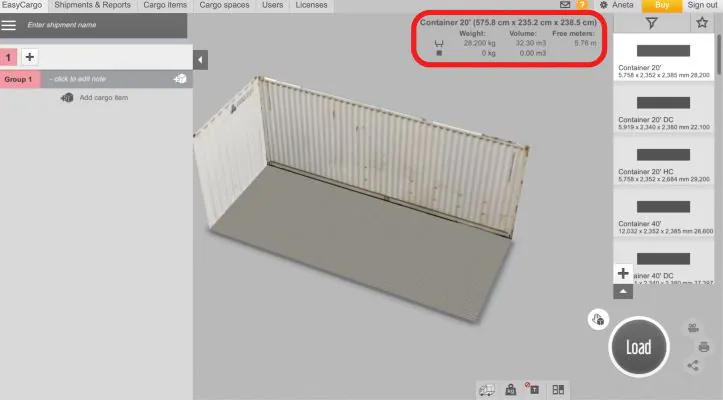
Manual Calculation of Container Volume
Manually calculating container volume is simple if you know the basic dimensions and apply the correct formula. It’s especially useful when working with custom cargo spaces when you don’t have access to software, or if you just want a quick check.
Formula
Volume = length × width × height
Where:
- length = internal length of the container
- width = internal width of the container
- height = internal height of the container
Before calculating container volume, make sure all of the dimensions are in the same units. That’s also another great thing about EasyCargo — the app allows you to easily switch between imperial and metric units.
What If Your Cargo Space Isn’t Standard?
If your container or cargo space doesn’t match one of the 45 predefined options, you can simply create your own custom cargo space. Whether you’re working with non-standard truck beds, pallets, or regional containers with unique dimensions, the app allows you to input the exact length, width, and height to match your real-world setup.
Just enter the dimensions once, save your custom space, and use it anytime — no workarounds or manual recalculations needed. With EasyCargo, flexibility is built right in.
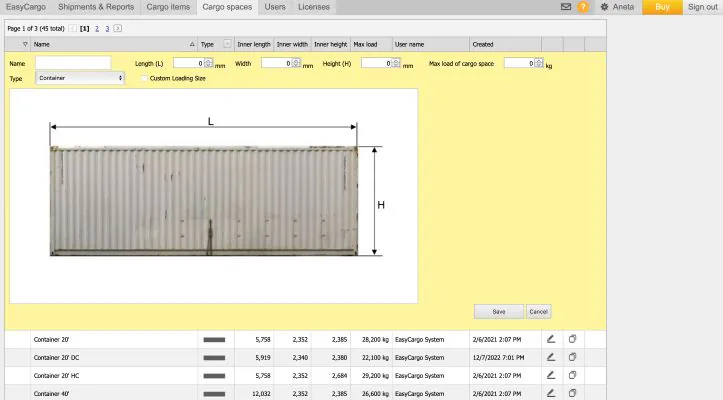
How to Use the EasyCargo Container Volume Calculator
Choosing the right container is just the beginning. What are the next steps to create an optimized container loading plan?
- Define your cargo items:
Enter the dimensions, weight, and quantity of each item you’re planning to load. The more precise your input, the more accurate your plan will be. - Set loading preferences:
Do your items need to be stacked? Should they be upright? Do you want to prioritize certain items at the front of the container? You can define all of that with just a few clicks. - Let the software do the work:
With all of the data entered, EasyCargo will generate the optimal loading plan based on volume, weight distribution, and loading rules. - Review and adjust if needed:
Visually check the 3D loading plan and make manual tweaks if necessary. - Export and share the plan:
Once you are satisfied, export the plan as a PDF or share it via a public link with your team, clients, or the warehouse staff.
With the EasyCargo app, you can create a container loading plan in just a few clicks — and most importantly, in a fraction of the time compared to manual planning. Instead of measuring, sketching, and calculating everything by hand, the software handles the heavy lifting for you.
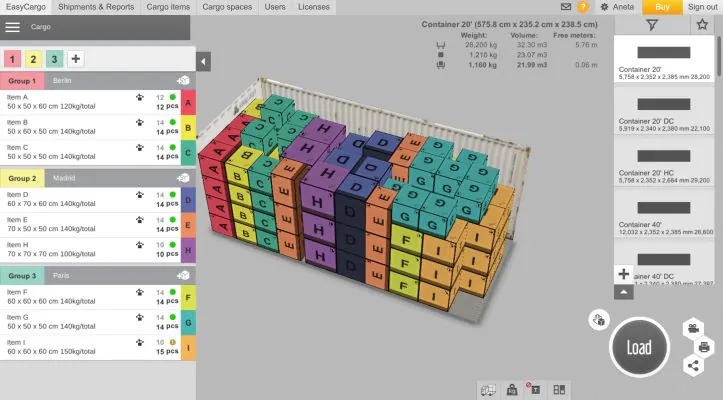
Why Does Container Volume Matter in Real Life?
Knowing the exact volume of your container isn’t just a technical detail. It directly impacts your efficiency, costs, and overall logistics performance. Miscalculating container space can lead to:
- underloaded/overloaded shipments,
- wasted space,
- transportation of air,
- improperly loaded containers, trucks, or pallets,
- or worse, attempting to load items that simply don’t fit.
That means higher transportation costs, delayed deliveries, and frustrated customers.
On the flip side, when you calculate container volume accurately, you:
- Maximize every cubic meter, reducing the number of trips.
- Save on shipping costs by avoiding partially filled containers.
- Speed up the loading process by having a clear plan.
- Prevent damage by ensuring a safe and stable loading process.
- Reduce CO₂ emissions by optimizing load capacity and minimizing unnecessary journeys.
In short, precise volume calculation is a small step that leads to major gains in real-world logistics.
Interesting fact: Did you know that optimizing your load plan to save just 7% of space can make a big difference — it’s like eliminating every 15th truck or container from your transport schedule. That’s not just smart logistics; it’s a win for the planet too. To put this into perspective: transporting one container from China to Europe generates around 1,900 kg of CO₂. By optimizing your shipments, you could cut nearly 2 tons of emissions for every 15 containers.
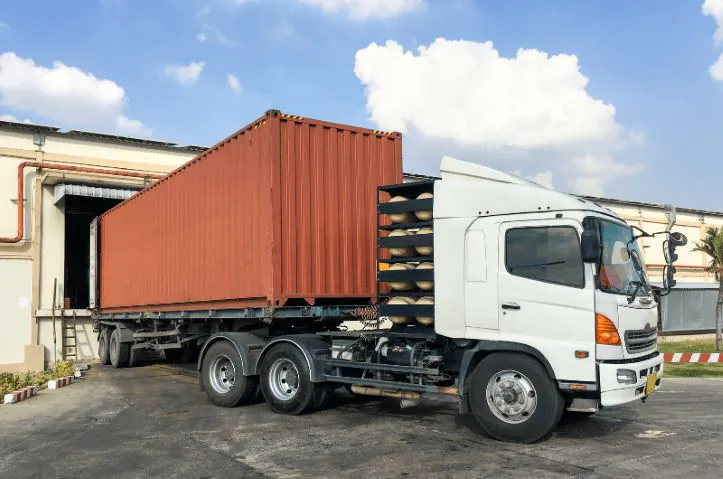
How Does Container Volume Affect Overall Supply Chain Performance?
Accurately calculating container volume doesn’t just impact a single shipment — it has a ripple effect across your entire supply chain. Here’s how:
Warehouse Efficiency
When you know exactly how much volume you work with, you can:
- Plan inventory levels better.
- Avoid unnecessary storage space usage.
- Minimize last-minute repacking or reallocation.
This results in faster turnaround times and smoother warehouse operations.
Transportation Optimization
With a well-calculated container volume:
- You reduce the number of partially filled containers.
- Plan routes and container shipments more effectively.
- Decrease the number of trips needed.
This means lower fuel costs, fewer vehicles on the road, and reduced emissions.
Better Customer Satisfaction
Nowadays, customers expect the products they order to arrive immediately, or at the very latest, the next day. What they definitely don’t want is a delayed delivery or having to wait longer than promised. And that’s exactly what could happen if you realize too late that the goods prepared for shipment don’t actually fit into the container. When your container volume is accurately calculated, all of the above lead to:
- Timely deliveries.
- Fewer delays or damaged shipments.
- Greater trust in logistics reliability.
Try It Yourself—For Free
The best way to see the benefits of accurate container volume calculation is to try it hands-on. With EasyCargo, you don’t just calculate—you optimize, visualize, and plan smarter. No more manual errors, wasted space, or stress over limits.
Start your 10-day free trial and explore all of the features without any commitment. Whether you’re shipping once a month or every day, EasyCargo helps you make the most of every shipment.
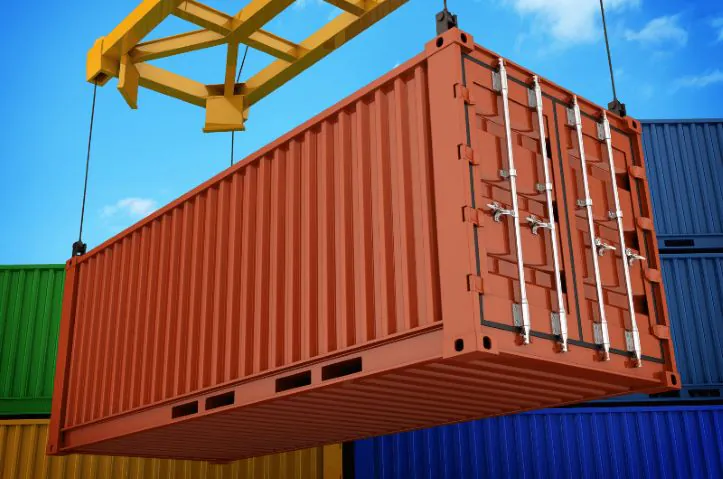
Common Mistakes When Calculating Container Volume
Even though calculating container volume seems straightforward, a few small missteps can lead to major problems down the line, like underused space, unexpected overloading, or costly delays. Here are some of the most common pitfalls to watch out for.
Forgetting to convert units
Mixing up units like centimeters and meters (or inches and feet) is one of the easiest mistakes to make. Always double-check that all dimensions are in the same units before calculating.
Using external instead of internal dimensions
When you look up the formula for calculating container volume, very few sources will tell you that you need to use internal dimensions. A few centimeters lost to walls or door frames can add up quickly. Therefore, keep in mind to always look for internal dimensions in the space.
Not accounting for packaging materials
It’s easy to measure just the product size, but boxes, pallets, protective wrapping, and air cushions also take up valuable space. Ignoring them leads to underestimating the actual volume your cargo occupies.
Not considering weight limits
Volume isn’t the only constraint—weight capacity matters too. You might have physical space left, but if you’re over the weight limit, you risk safety issues or fines.
Always consider both cubic capacity and maximum payload for your chosen container. When using the EasyCargo app, you don’t need to worry about weight limits at all. As you create your loading plan, the app automatically checks whether you’re exceeding the allowed limit. In the cargo space info panel, you can immediately see how much space and weight are available before reaching the maximum capacity.
Tip: Check out the video tutorial on how to work with the weight of a shipment.
Containers are an Essential Part of International Logistics
As we mentioned at the beginning, they may look simple on the outside, but containers are the backbone of modern global trade. Standardized, stackable, and incredibly versatile, shipping containers have revolutionized the way goods are transported across continents.
Here are a few statistics from contimod.com (Yaqub, Mohammad, 2025) that clearly show just how vital containers are to the global logistics system:
- Every year, an estimated 799 million shipping containers are shipped worldwide.
- Approximately 5,600 container ships operate worldwide.
- More than 60% of the world’s consumer goods are transported via shipping containers, worth nearly 14 trillion dollars.
- Container shipping accounts for 11% of global transportation CO2 emissions.
Tip: Do you want to know what drives the cost of shipping containers? From container types and port charges to freight surcharges and inland transport, this article breaks it all down and shows how proper load planning can help you avoid unnecessary expenses.
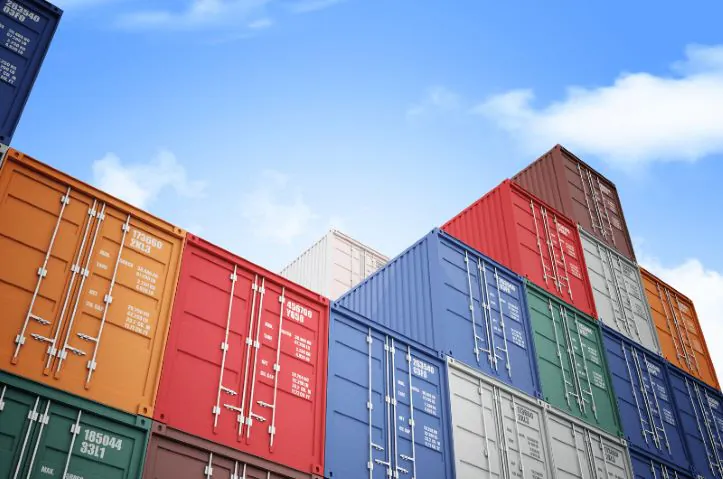
Frequently Asked Questions
1. How do you calculate the volume of a container in gallons?
Measure the dimensions of the container (internal length, width, and height). You can use inches, feet, or centimeters — just keep units consistent.
Calculate the volume in cubic units (e.g., cubic feet/inches or cubic centimeters/meters). Here is the formula: Volume = Length × Width × Height
Convert the volume to gallons:
- 1 U.S. gallon equals 231 cubic inches.
- 1 U.S. gallon equals 7.48 cubic feet.
- 1 U.S. gallon equals 3,785 cubic centimeters.
- 1 U.S. gallon equals 0.0038 cubic meters.
2. What happens if I exceed the weight limit of a container?
Overloading a container can lead to safety risks, damage, or even fines. It puts stress on the vehicle and increases the risk of accidents during transport. Additionally, exceeding the weight limit can cause uneven weight distribution, which affects the balance and stability of the shipment.
3. What does CBM mean?
CBM stands for Cubic Meter (m³). It’s a standard unit of measurement used in shipping and logistics to express the volume of cargo.
Formula is: CBM = Length × Width × Height (in meters)
4. What is the CBM of a 40 ft. container?
A standard 40-foot container has an internal volume of approximately 67 cubic meters (m³).
However, this can vary slightly depending on the container type:
- 40 ft. Standard Container: ~67.7 m³
- 40 ft. High Cube Container (taller version): ~76.3 m³
Make Every Cubic Meter Count
Accurately calculating container volume isn’t just about fitting cargo—it’s about making smart, cost-effective logistics decisions that ripple across your entire supply chain. Whether you’re shipping globally or managing local deliveries, using a reliable tool like the EasyCargo container volume calculator saves time, improves space utilization, and ensures every shipment is optimized from the start.
Are you ready to streamline your loading process, minimize costs, and improve delivery performance? Try EasyCargo for free and experience how much smoother logistics can be when container volume is calculated the right way.




